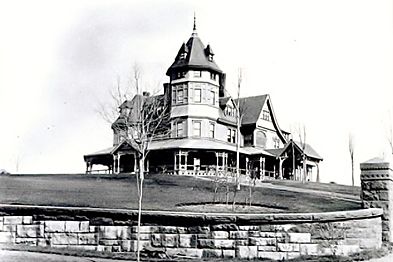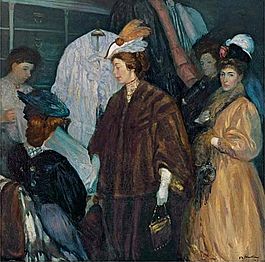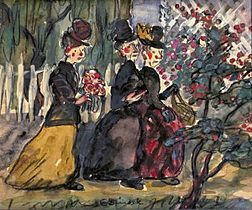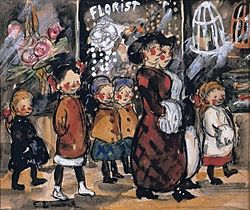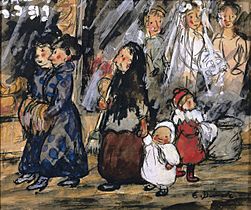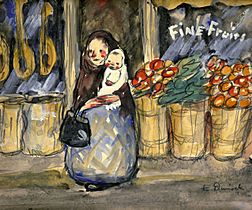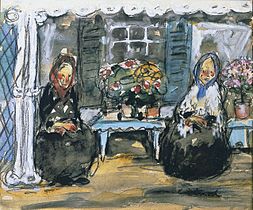Edith Dimock facts for kids
Quick facts for kids
Edith Dimock Glackens
|
|
|---|---|
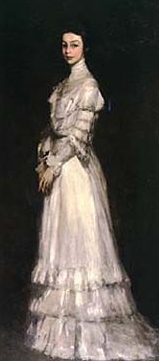
Robert Henri, Portrait of Edith Dimock Glackens, ca. 1902–4, Sheldon Museum of Art
|
|
| Born |
Edith Dimock
February 16, 1876 |
| Died | October 28, 1955 (aged 79) |
| Nationality | American |
| Education | Art Students League, William Merritt Chase |
| Spouse(s) | William Glackens |
Edith Dimock (born February 16, 1876 – died October 28, 1955) was a talented American painter. Her artwork was shown at a very important art exhibition in New York in 1913 called the Armory Show. She married another artist, William Glackens, but she kept using her maiden name, Dimock, for her art.
About Edith's Life
Edith Dimock was born in 1876 in Hartford, Connecticut. Her family called her "Teed." Her father, Ira Dimock, was a silk merchant. Edith loved art from a young age. When she was in her 20s, she started studying art in New York. This was even though her parents didn't want her to.
On February 16, 1904, she married another painter, William Glackens. Their wedding was at her family's large home in Connecticut. As a wedding gift, artist Robert Henri painted portraits of Edith and William. Edith's portrait was started in 1902.
At first, Edith and William lived in a small apartment in New York City. Later, they moved to a bigger home near Washington Square Park. After getting married, Edith spent a lot of time focusing on her family. Their son, Ira, was born in 1907. He grew up to be a writer and wrote books about his father. In 1913, their daughter, Lenna, was born. Lenna also became an artist. Both Edith and Lenna were often models for William Glackens' paintings.
From 1911 to 1917, the Dimock family spent their summers in Belport on Long Island. There, William Glackens painted many beach scenes. Their good friends, artists May Wilson Preston and James Moore Preston, often joined them for these summers. They also traveled to Europe together.
Edith was also involved in the women's suffrage movement. This was a movement to gain voting rights for women. She was an honorary secretary for a suffrage group in 1911 and 1915. In 1913, she marched in a big suffrage parade in New York with other artists.
Edith's husband, William, passed away in 1938. Edith Dimock died on October 28, 1955, at her home in Hartford.
Edith's Art Career
Edith Dimock studied art at the Art Students League of New York from 1895 to 1899. She learned from famous artists like William Merritt Chase. Edith once described her art classes:
In a room innocent of ventilation, the job was to draw Venus (just the head) and her colleagues. We were not allowed to hitch bodies to the heads——yet. The dead white plaster of Paris was a perfect inducer of eye-strain, and was called "The Antique." One was supposed to work from "The Antique" for two years. The advantage of "The Antique" was that all these gods and athletes were such excellent models: there never was the twitch of an iron-bound muscle. Venus never batted her hard-boiled egg eye, and the Discus-thrower never wearied. They were also cheap models and did not have to be paid union rates.
– Edith Dimock
After the Art Students League, she continued to study with Chase at the New York School of Art. Edith shared an art studio in Manhattan with May Preston and another artist. These three women were known as the "Sherwood Sisters." They often hosted open houses. They also met with male artists from the Ashcan School, like William Glackens. Even after marrying in 1904, Edith continued to sign her artworks with her maiden name, Dimock.
In 1904, her paintings were shown at the American Water Color Society exhibition. A review from the Evening Star newspaper said:
Miss Dimock is not unorthodox at all. She comes to her world very unconventionally, free from pictorial prejudice, and with a purpose which is not complicated by unsettled notions. Her attitude to life is the precise antithesis of the attitude that prevails in this exhibition, where unattached sentiment rules and the 'picture instinct' is so much too strong for original observation. Here is an artist with a definite aim, a keen fresh vision.
– Evening Star review
Edith often painted everyday scenes using watercolors. Her works were charming and sometimes showed a funny side. She also illustrated children's books. These included Grace Van Rensselaer Dwight's The yellow cat and her friends (1905) and Kate Forrest Oswell's Stories Grandmother Told (1912).
In 1908, her works were shown with seven other painters at the Macbeth Galleries. Edith Dimock also showed eight of her artworks at the famous 1913 New York Armory Show. These included paintings like Sweat Shop Girls in the Country and Mother and Daughter. She also showed six paintings titled Group.
In 1928, her watercolor portraits were shown at the Whitney Studio Club. These works then traveled to other museums. These included the Art Students League of New York, the Fogg Museum of Art, the Denver Art Museum, and the Minneapolis Institute of Arts. They were also shown at the California Palace of the Legion of Honor in San Francisco. The Whitney Studio Club also held a special show just for Edith Dimock's art.
See also


